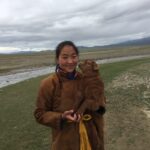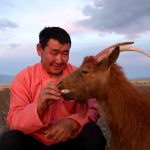
“The prosperity of herders follows the prosperity of the herd. If you succeed to love the herd, the herd will repay with love”
Altansukh T, Bayan Tol Cooperative
HOW WE ENSURE ANIMAL WELFARE
Maintaining a healthy goat herd is crucial to cashmere producers’ way of life and future prosperity. Through our training and certification programme, we draw on traditional knowledge and scientific evidence and promote internationally-recognised best practice to ensure the health and well-being of cashmere goats.
The SFA Animal Fibre Standard has moved away from the Five Freedoms and is based on the Five Domains model of animal welfare. This is to ensure that our standard encourages positive experiences and emotional states for goats, as well as minimising suffering and discomfort as much as possible.
Nutrition
Physical Environment
Health
Behavioural Interactions
Mental State
NOMADIC & FARMED CASHMERE
Herders in Mongolia are nomadic, grazing their goats on communally-owned land and shifting between pastures throughout the year. They typically keep a mix of livestock species, including goats, sheep, yak, camel and horses. Livestock are crucial to this way of life, providing people with transportation, food and clothing.
In contrast, China has undergone a vast shift in the way livestock are raised. Grazing land has been privatised and herders are no longer nomadic, instead raising their goats in fenced fields and barns in a way that’s more similar to Western-style farming.
The SFA believes that responsible cashmere production can be achieved in both systems. We recognise the different sustainability and welfare challenges they present, and the need for a globally-applicable but locally-relevant standard that can be adapted to each country’s context.
In our experience, cashmere producers across the globe share a close bond with their animals that is built on mutual dependence and respect.





